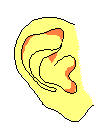 | Hearing (Audition) |  |
 | Hearing (Audition) |  |
 |
Some of these experiments require a blindfold. Keep in mind that some people do not like to be blindfolded...you could ask them to keep their eyes closed, but don't count on them having their eyes closed for a very long time. You might also be interested in some background information about the ear and hearing. |  |
|
|
|
|
|
|
|
|
|
|
|
|
 Complete lesson
plan on hearing with Teacher Resource, Teacher Guide and Student
Guide.
[Back to Top]
Complete lesson
plan on hearing with Teacher Resource, Teacher Guide and Student
Guide.
[Back to Top]
| GO TO: | Hearing | Smell | Taste | Touch | Vision | Working Together |
| BACK TO: | The Senses | Experiments and Activities | Table of Contents |
![[email]](./gif/menue.gif) Send E-mail |
![[newsletter]](./gif/menunew.gif) Get Newsletter |
![[search]](./gif/menusea.gif) Search Pages |
 Donate to Neuroscience for Kids |